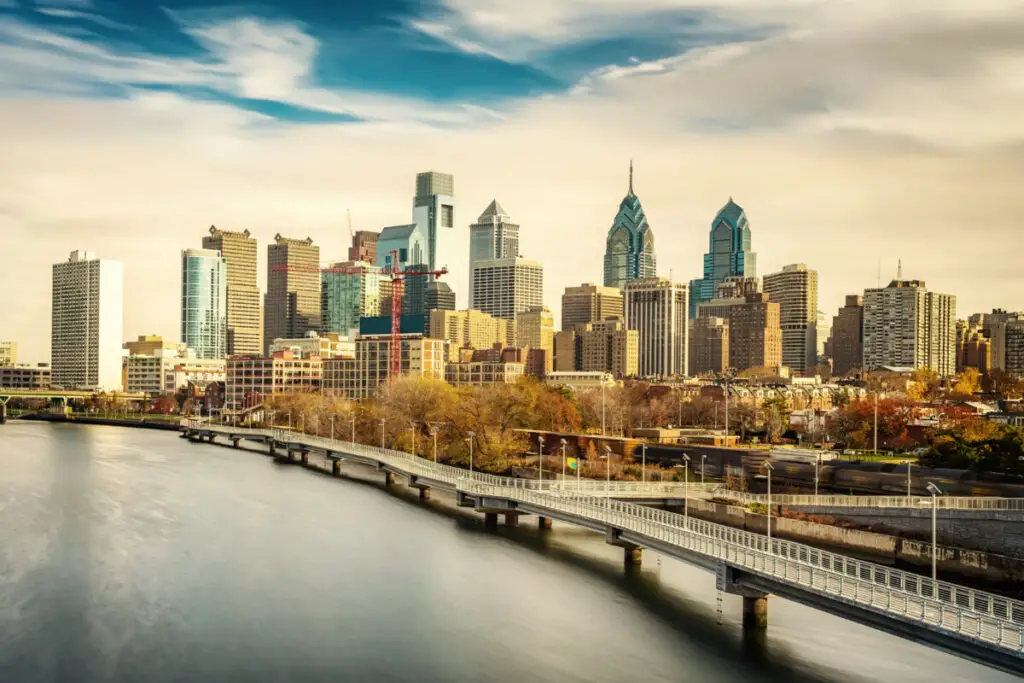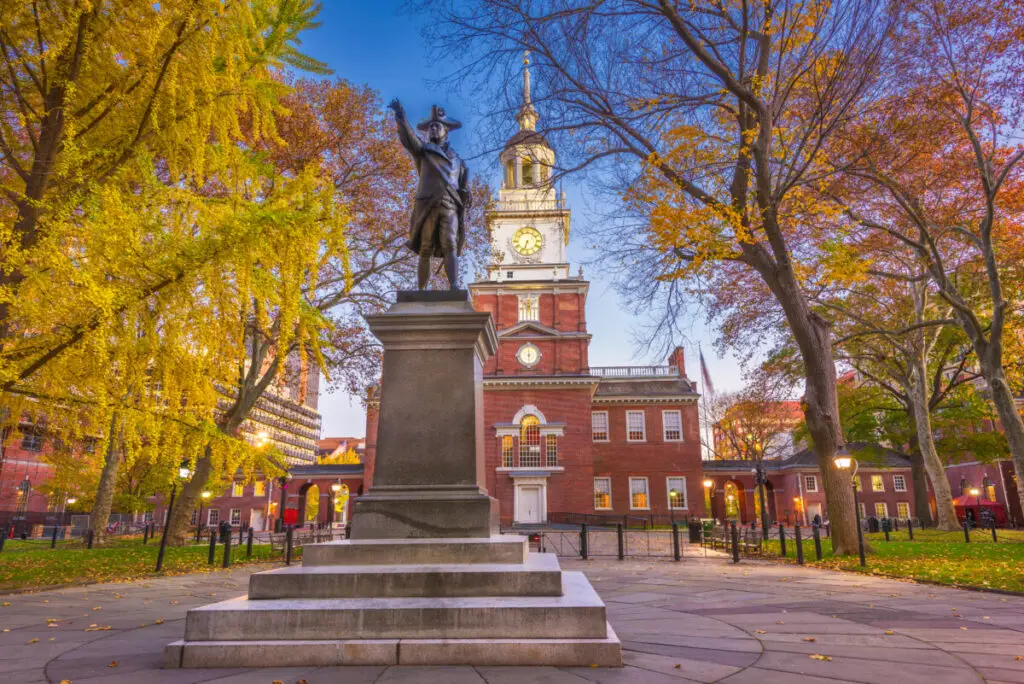
Politics are becoming more and more important to our society, and many people want to know that their neighbors have the same political beliefs that they have. Do residents of Philadelphia tend to be liberal or conservative?
Philadelphia, Pennsylvania is a very liberal city. The majority of residents voted for the Democratic candidate in every election since 2000. Philadelphia County is also very liberal and always votes Democratic, while Pennsylvania is a swing state that tends to vote for the Democratic candidate.
There are many factors to the political climate of a city. When deciding whether a city is liberal or conservative, we must consider the results of the presidential election, the local leaders, the policies, and the demographics.
Presidential Elections
The results of presidential elections in a city are an important indicator of whether the city is liberal or conservative. The two major political parties in the United States, the Democratic party and the Republican party, and their candidates are representative of the liberal and conservative perspectives.
The Democratic party has mostly liberal members and supports liberal policies, so if the majority of residents in a city vote for the Democratic candidate, the city is mostly liberal. The Republican party has mostly conservative members and supports conservative policies, so the city is most likely conservative if it votes mostly for the Republican candidate.
Pennsylvania is a swing state . Most states can be counted on to vote for either the Democratic or Republican candidate in the presidential election. However, there are certain states that can go either Democratic or Republican. The results of the election are usually determined by the candidate the majority of residents of these swing states vote for.
. Most states can be counted on to vote for either the Democratic or Republican candidate in the presidential election. However, there are certain states that can go either Democratic or Republican. The results of the election are usually determined by the candidate the majority of residents of these swing states vote for.
Pennsylvania is a swing state, so the elections can go either way, though the state tends to vote Democratic. From 2000 to 2020, Pennsylvania voted for the Democratic candidate in five out of the six elections. The only election in which they voted for the Republican candidate was the 2016 presidential election.
What makes Pennsylvania a swing state is the fact that the percentages of Democratic and Republican voters are so close. The differences between the percentages are very low. The smallest difference between percentages was 0.7% in 2016; the Republican candidate won by that small percentage. The largest difference was 10.3% in 2008. Essentially, the percentages are so close that it wouldn’t take very much for the tide to turn and another candidate to win.
In the 2020 presidential election, the Democratic candidate won with 50.0% of the votes, while the Republican candidate got 48.8% of the vote. The difference between the two percentages was 1.2%, which was the second lowest after 2016.
Philadelphia County, which is the county that the city of Philadelphia is in, is a very liberal area. The Democratic candidate has won with over 80% of the vote in the county in every election for the past 20 years. The largest difference between the percentages of Democratic votes and Republican votes was 71.32% in 2012, and the smallest difference was 61.14% in 2004. Though Pennsylvania elections are close calls, the Democratic candidate wins in a landslide in Philadelphia County.
area. The Democratic candidate has won with over 80% of the vote in the county in every election for the past 20 years. The largest difference between the percentages of Democratic votes and Republican votes was 71.32% in 2012, and the smallest difference was 61.14% in 2004. Though Pennsylvania elections are close calls, the Democratic candidate wins in a landslide in Philadelphia County.
In the 2020 election, 81.21% of Philadelphia County residents voted for the Democratic candidate, while 17.86% voted for the Republican candidate. The difference between the percentages is 63.35%, which is the third lowest difference after 2004 and 2000.
The city of Philadelphia, just like its county, is very liberal. Philadelphia voted for the Democratic candidate in every election from 2000 to 2020. The difference in the percentages of Democratic and Republican votes was higher than 10% in every election, which means that the races were not close by any means. Philadelphia has similar percentages to its county.
From 2018 to 2021, there were 120,270 contributions to the Democratic party in Philadelphia, Pennsylvania. These contributions came to a total of $55,485,526. In contrast, there were 6,770 contributions to the Republican party which totaled $3,348,834. The average donation amounts were approximately the same for both parties.
Local Leaders

The local leaders of a city are another big indicator of the political climate of the city. These are people that the residents of the city have elected to represent based on their political party, beliefs, or promises. We need to look at the political parties, campaign platforms, and political achievements of Philadelphia’s elected leaders and representatives before deciding whether the city is liberal or conservative.
Mayor
The mayor of Philadelphia proposes a budget, signs laws, appoints certain city employees, oversees the operations of the city, and represents it in larger matters.
The current mayor of Philadelphia is James Kenney . He was elected in 2016, then reelected in 2019, which means that the people liked both his campaign platform and what he achieved during his first term in office.
. He was elected in 2016, then reelected in 2019, which means that the people liked both his campaign platform and what he achieved during his first term in office.
Mayor Kenney has spent his time in the office working on anti-poverty initiatives, improving the education system, creating economic opportunities, improving public safety, diversifying the workforce, and making the city government more efficient. He is also focused on racial equality and economic recovery from the COVID-19 pandemic.
Mayor Kenney is affiliated with the Democratic party. His focus in office and the policies he has enacted also show that he has a liberal perspective.
City Council
The Philadelphia City Council is responsible for adopting or changing the budget, approving mayoral appointees, imposing taxes, and changing or adding city laws.
is responsible for adopting or changing the budget, approving mayoral appointees, imposing taxes, and changing or adding city laws.
There are seventeen city council members. Seven of these city councilors are elected by the city at large and ten of them are elected by one of the ten districts in Philadelphia. Fourteen of the current city councilors are Democratic, two are Republican, and one is independent.
Policies

The policies that are in place in an area can also be indicative of political leanings. Some policies are more likely to be supported or opposed by liberals or conservatives. Legal abortion, more gun control laws, and legal same-sex marriage are most likely to be supported by liberals and opposed by conservatives.
Abortion
As of August of 2022, in Pennsylvania, abortions must be performed 24 weeks before the last menstrual period except when the life or health is in danger. Public funding and health plans cannot be used to cover abortions. Before receiving an abortion, a patient must attend counseling that is designed to discourage abortions. The parents of a minor must consent before that minor can receive an abortion, and abortion clinics have to meet strict standards.
must be performed 24 weeks before the last menstrual period except when the life or health is in danger. Public funding and health plans cannot be used to cover abortions. Before receiving an abortion, a patient must attend counseling that is designed to discourage abortions. The parents of a minor must consent before that minor can receive an abortion, and abortion clinics have to meet strict standards.
As of 2017, there were 43 facilities that provide abortions in Pennsylvania, 18 of which were clinics. This is a 10% decline from 2014. 85% of Pennsylvania counties did not have abortion clinics, which left 48% of women without access to a clinic.
Philadelphia residents tend to support a decrease in abortion laws, allowing more women access to abortions.
Gun Control Laws
Pennsylvania had the 20th lowest gun death rate and 15th lowest gun export rate in the country in 2020. Pennsylvania gun laws include universal background checks for handguns, domestic violence gun laws, an extended background check period, state database background checks, disarming procedures, gun dealer regulation, and firearm arm sale record retention.
include universal background checks for handguns, domestic violence gun laws, an extended background check period, state database background checks, disarming procedures, gun dealer regulation, and firearm arm sale record retention.
Pennsylvania gun laws do not include universal background checks for long guns, gun owner licensing, assault weapon or large capacity magazine restrictions, waiting periods, concealed or open carry regulations, or child access prevention laws.
Philadelphia residents tend to support an increase in gun laws so there will be more regulation on guns.
Same-Sex Marriage
Pennsylvania legalized same-sex marriage on May 20, 2014 . This was about one year before the Supreme Court mandate required all states to legalize same-sex marriage. Pennsylvania was the 18th state to make same-sex marriage legal. Philadelphia residents supported the decision to make it legal.
. This was about one year before the Supreme Court mandate required all states to legalize same-sex marriage. Pennsylvania was the 18th state to make same-sex marriage legal. Philadelphia residents supported the decision to make it legal.
Demographics
The population of Philadelphia is about 1,578,487 people. The population density is 11,759 people per square mile. 52.7% of residents are female and 47.3% are male. The median age is 33.6, and the average number of people per household is 2.6.
of Philadelphia is about 1,578,487 people. The population density is 11,759 people per square mile. 52.7% of residents are female and 47.3% are male. The median age is 33.6, and the average number of people per household is 2.6.
The racial makeup of Philadelphia is as follows:
of Philadelphia is as follows:
- White: 34.9%
- Black: 41.3%
- Hispanic/Latino: 14.1%
- Asian: 7.0%
- Native American: 0.2%
- Hawaiian/Pacific Islander: 0.0%
- Two or More Races: 2.0%
- Other: 0.3%
32.7% of Philadelphia residents are married and 9.0% are divorced. 21.3% of residents are married with children and 29.7% are single with children.
of Philadelphia residents are married and 9.0% are divorced. 21.3% of residents are married with children and 29.7% are single with children.
The average income of Philadelphia residents is $22,542 per year, and the median household income is $37,460 per year. The unemployment rate is 10.6%. The sales tax rate is 8.0%, and the income tax rate is 7.0%.
of Philadelphia residents is $22,542 per year, and the median household income is $37,460 per year. The unemployment rate is 10.6%. The sales tax rate is 8.0%, and the income tax rate is 7.0%.
83.3% of Philadelphia residents are high school graduates, and 16.8% are only high school graduates. 15.8% of residents have two-year degrees, 27.1% have four-year degrees, 2.4% have master’s degrees, and 1.4% have professional degrees.
of Philadelphia residents are high school graduates, and 16.8% are only high school graduates. 15.8% of residents have two-year degrees, 27.1% have four-year degrees, 2.4% have master’s degrees, and 1.4% have professional degrees.
49.5% of Philadelphia residents are religious. 44.5% are Christian, 1.1% are Jewish, 1.1% are of eastern faith, and 2.6% are affiliated with Islam.
of Philadelphia residents are religious. 44.5% are Christian, 1.1% are Jewish, 1.1% are of eastern faith, and 2.6% are affiliated with Islam.
The rate of violent crime in Philadelphia on a scale of 1 to 100 is 50.8. The rate of property crime on a scale of 1 to 100 is 46.6. Both of these crime rates are higher than the national average.

